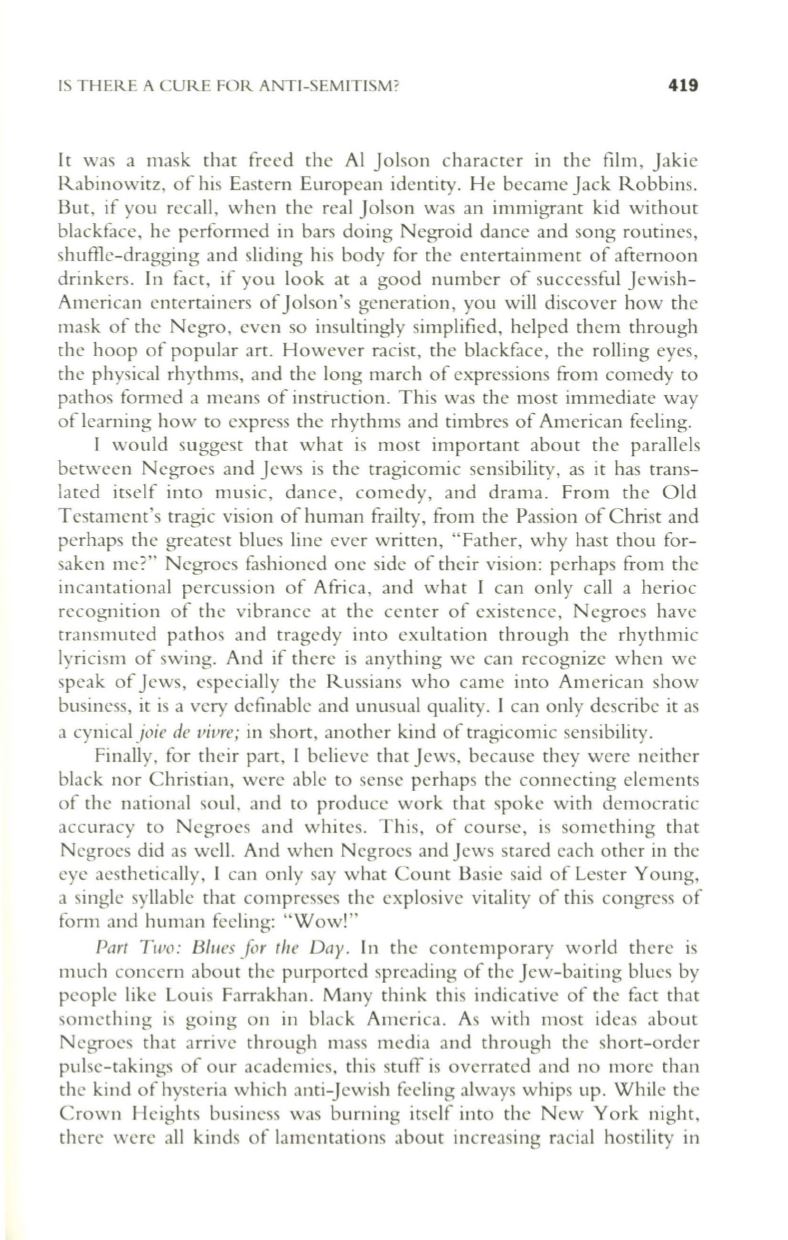
IS THERE A CURE FOR ANTI-SEMITISM;>
419
It was a mask that freed the Al Jolson character in the film, Jakie
Rabinowitz, of his Eastern European identity. He became Jack Robbins.
But, if you recall, when the real Jolson was an immigrant kid without
blackface, he performed in bars doing Negroid dance and song routines,
shume-dragging and sliding his body for the entertainment of afternoon
drinkers. In fact, if you look at a good number of successful Jewish–
American entertainers of J olson's generation, you will discover how the
mask of the Negro, even so insultingly simplified, helped them through
the hoop of popular art. However racist, the blackface, the rolling eyes,
the physical rhythms, and the long march of expressions from comedy to
pathos formed a means of instruction. This was the most immediate way
of learning how to express the rhythms and timbres of American feeling.
I would suggest that what is most important about the parallels
between Negroes and Jews is the tragicomic sensibility, as it has trans–
lated itself into music, dance, comedy, and drama. From the Old
Testament's tragic vision of human frailty, from the Passion of Christ and
perhaps the greatest blues line ever written, "Father, why hast thou for–
saken me?" Negroes fashioned one side of their vision: perhaps from the
incantational percussion of Africa, and what I can only call a herioc
recognition of the vibrance at the center of existence, Negroes have
transmuted pathos and tragedy into exultation through the rhythmic
lyricism of swing. And if there is anything we can recognize when we
speak of Jews, especially the Russians who came into American show
business, it is a very definable and unusual quality. I can only describe it as
a cynical
joie de vivre;
in short, another kind of tragicomic sensibility.
Finally, for their part, I believe that Jews, because they were neither
black nor Christian, were able to sense perhaps the connecting elements
of the national soul, and to produce work that spoke with democratic
accuracy
to
Negroes and whites. This, of course, is something that
Negroes did as well. And when Negroes and Jews stared each other in the
eye aesthetically, I can only say what Count Basie said of Lester Young,
a single syllable that compresses the explosive vitality of this congress of
form and human feeling: "Wow!"
Part Two: Billes Jor the Day.
In the contemporary world there is
much concern about the purported spreading of the Jew-baiting blues by
people like Louis Farrakhan. Many think this indicative of the fact that
something is going on in black America. As with most ideas about
Negroes that arrive through mass media and through the short-order
pulse-takings of our academies, this stuff is overrated and no more than
the kind of hysteria which anti-Jewish feeling always whips up. While the
Crown Heights business was burning itself into the New York night,
there were all kinds of lamentations about increasing racial hostility in


